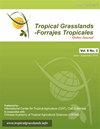Effects of a nitrogen-based supplement on intake, live weight and body energy reserves in breeding Bos indicus cross cows
IF 0.7
4区 农林科学
Q3 AGRICULTURE, DAIRY & ANIMAL SCIENCE
引用次数: 0
Abstract
Breeding cows grazing seasonally dry rangelands usually lose substantial live weight (LW) during the dry season, when in late pregnancy. An experiment investigated the effects of feeding a N-based supplement to cows in late pregnancy on voluntary intake, total live weight (T-LW), body condition score (CS) and estimated body net energy content (Body-NE), as well as carry-over effects during lactation. In Phase A for 139 days from mid-pregnancy, mature Bos indicus cross breeders [initially 438 kg T-LW and 5.7 CS units (9-point scale)] were fed in pens on low quality tropical grass hay alone (Control) or with a N supplement (Supplemented). Most (17/22) of the cows calved during this interval. Voluntary hay intake averaged 6.74 g DM/kg T-LW/d in Control cows, and was increased by 35% (P<0.001) when supplement was fed. As a result, feeding supplement reduced loss in conceptus-free live weight (CF-LW) by 30% (from 1.11 kg/d to 0.78 kg/d; P<0.001) and in Body-NE by 20% (from 26.6 to 21.2 MJ NE/d; P = 0.007). Control cows mobilized 24% of maternal LW and 32% of body energy when fed low quality hay during late pregnancy, and these losses were substantially reduced when a N-based supplement was fed. During Phase B, when the lactating cows with their calves grazed a high quality rainy season grass-Stylosanthes pasture, the previously supplemented cows produced more milk (P = 0.065) and their calves grew faster (P = 0.077) in early lactation than Control cows. In addition, during early lactation Control cows exhibited compensatory LW gain relative to the Supplemented cows (0.80 vs. 0.43 kg/d, respectively; P<0.001) and there was no discernable weight difference between the groups by 205 days of lactation. In conclusion the losses in LW and body energy reserves by late pregnant cows fed low quality tropical grass hay were substantially reduced by a N supplement, but the differences were not maintained when the cows subsequently grazed high quality pasture.氮基饲粮对籼稻杂交奶牛采食量、活重和体能储备的影响
在季节性干旱牧场放牧的种牛在旱季妊娠后期通常会损失大量的活重。本试验研究了妊娠后期饲喂氮基饲粮对奶牛自愿采食量、总活重(T-LW)、体况评分(CS)和估算体净能含量(body - ne)的影响,以及泌乳期的结转效应。在A阶段,从妊娠中期开始的139天,成熟的籼稻杂交种猪[初始438 kg T-LW和5.7 CS单位(9分制)]在围栏中单独饲喂低质量热带干草(对照)或添加氮(补充)。大多数奶牛(17/22)在此期间产犊。对照组奶牛自愿采干草量平均为6.74 g DM/kg T-LW/d,添加饲料后平均采干草量增加35% (P<0.001)。结果表明,添加饲料可降低30%的无胎活重(CF-LW)损失(从1.11 kg/d降至0.78 kg/d;P<0.001), Body-NE减少20%(从26.6 MJ NE/d增加到21.2 MJ NE/d;P = 0.007)。对照奶牛在妊娠后期饲喂低质量干草时,消耗了24%的母畜LW和32%的身体能量,饲喂氮基补饲后,这些损失大大减少。在B阶段,当乳牛带着小牛放牧优质雨季草-茎柱草草场时,补饲前的奶牛泌乳早期产奶量高于对照奶牛(P = 0.065),犊牛生长速度也快于对照奶牛(P = 0.077)。此外,在泌乳早期,对照组奶牛相对于添加组奶牛表现出补偿性增重(0.80 vs 0.43 kg/d);P<0.001),哺乳期第205天各组之间没有明显的体重差异。综上所述,补氮显著降低了饲喂低品质热带牧草的妊娠后期奶牛的LW损失和体能储备损失,但在随后饲喂高品质牧草时,这种差异并未保持。
本文章由计算机程序翻译,如有差异,请以英文原文为准。
求助全文
约1分钟内获得全文
求助全文
来源期刊

Tropical Grasslands-Forrajes Tropicales
Agricultural and Biological Sciences-Agronomy and Crop Science
CiteScore
1.60
自引率
0.00%
发文量
36
审稿时长
16 weeks
期刊介绍:
The Journal publishes, in English or Spanish, Research Papers and Short Communications on research and development, as well as contributions from practitioners (Farmer Contributions) and Review Articles, related to pastures and forages in the tropics and subtropics. There is no regional focus; the information published should be of interest to a wide readership, encomprising researchers, academics, students, technicians, development workers and farmers.
In general, the focus of the Journal is more on sown (''improved'') pastures and forages than on rangeland-specific aspects of natural grasslands, but exceptions are possible (e.g. when a submission is relevant for a particularly broad readership in the pasture and forage science community).
The Journal will also consider the occasional publication of associated, but closely related, research in the form of an additional scientific communication platform [e.g. a re-make of the former Genetic Resources Communication series of the former Division of Tropical Crops and Pastures of the Commonwealth Scientific and Industrial Research Organisation (CSIRO), Australia].
Areas of particular interest to the Journal are:
Forage Genetic Resources and Livestock Production[...]
Environmental Functions of Forages[...]
Socio-economic Aspects[...]
Topics within the aforementioned areas may include: Diversity evaluation; Agronomy; Establishment (including fertilization); Management and utilization; Animal production; Nutritive value; Biotic stresses (pests and diseases, weeds); Abiotic stresses (soil fertility, water, temperature); Genetics and breeding; Biogeography and germplasm collections; Seed production; Ecology; Physiology; Rhizobiology (including BNF, BNI, mycorrhizae); Forage conservation; Economics; Multilocational experimentation; Modelling.
 求助内容:
求助内容: 应助结果提醒方式:
应助结果提醒方式:


